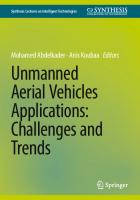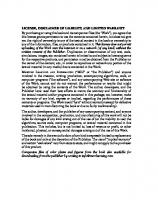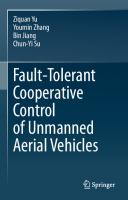Unmanned Aerial Vehicles Applications: Challenges and Trends 3031320360, 9783031320361
This is a book that covers different aspects of UAV technology, including design and development, applications, security
343 113 11MB
English Pages 403 [404] Year 2023
Table of contents :
Contents
Design and Development
Tetrahedral and Dodecahedral UASs, Structured Designs
1 Introduction
1.1 A Brief History of Unmanned Aerial Vehicles
1.2 A Brief History of Modular Flying Machines
1.3 The Structured Modular UAV Solution
2 Prototypes
2.1 Tetracopter
2.2 TetraheDrone
2.3 Dodecacopter
3 Structural Considerations
4 Aerodynamics
4.1 TetraheDrone considerations
5 System Control
5.1 Control Under Uncertainty
6 Summary
Top-Down Design Approach for the Customization and Development of Multi-rotors Using ROS
1 Introduction
1.1 Unmanned Aerial Vehicles in Society
1.2 Robot Operating System (ROS)
1.3 Applications of UAVs
1.4 Challenges in the Development of UAVs
1.5 Organization of Content
2 Background and Related Work
3 Proposed Methodology
3.1 Top-Down Design Approach for the Development of Customized UAVs
4 Design of Autonomous UAVs
4.1 Consideration of Design Specifications
4.2 Typical Hardware Architecture of Multi-rotors
4.3 Hardware Development of Multi-rotor UAVs
4.4 Customized, Application-Specific Payloads
5 Software Development of Autonomous UAVs
5.1 ROS for Multi-rotor UAVs
5.2 Simulation of ROS-Based Multi-rotors Using Gazebo
6 Example Case: Autonomous Quadcopter for Water Transportation
6.1 Hardware Development
6.2 Software Development
7 Conclusion
References
Robust and Intelligent Kalman Filter Residue-Based Trajectory Tracking and Fault-Tolerant Control of Quadrotor Using Bayes Classifier Fusion
1 Introduction
2 Background
2.1 Machine Learning, Deep Learning and Predictive Analytics
2.2 Linear Parameter-Varying Model
2.3 Internal Model Principle
2.4 Feedback-Feed Forward Controller
2.5 Box-Jenkins Model
2.6 Emulator-Based Two-Stage Identification Method
2.7 Practical Applications
2.8 Main Contributions
3 Kinematics: Translation and Rotation
4 Dynamic Model
4.1 Dynamics of Translational Motion
4.2 Dynamics of Rotational Motion
5 Disturbance and Measurement Noise
5.1 State-Space Models of the Disturbances
5.2 The Inaccessible Input Signals
5.3 Nonlinear State-Space Model
6 Piecewise-Linear Dynamic Model
6.1 Linear Parameter-Varying Model
6.2 Piecewise Linear Dynamic Box-Jenkins Model
7 Feedback and Feedforward Controller Design
7.1 Feedback Controller: An Internal Model-Based Design Approach
7.2 Feedforward Controller Design
7.3 Combined Feed-Forward-Feedback Controller
7.4 Closed-Loop Signal Model Derivation
7.5 Box-Jenkins Model of the System
8 Kalman Filter Design
8.1 The Residual Model of the KF
8.2 Identification of Signal Model, Disturbance Model, Estimates of Signal, and Output Error
8.3 KF for the Signal Model
9 Emulator-Based Identification Method
9.1 Signal Model
9.2 Disturbance Model
9.3 KF-Based State Feedback and Feedforward Controller
9.4 Feedforward Controller
9.5 Fault Isolation
9.6 Condition-Based Maintenance
9.7 Fault Tolerance
10 Evaluation of the Proposed Scheme on a Quadrotor
10.1 Estimation of the True Input Using Machine Learning
10.2 The Closed-Loop Signal, Disturbance Models
10.3 The Extraction of the Signal Using a KF
10.4 Tracking Performance: KF-Aided Tracking of Signals and Their Corrupted Versions
10.5 Tracking Performance: Adaptive Filter Approach
11 KF-Based Soft Sensor Design
11.1 KF-Based Soft Sensor
12 Fault Tolerant System: An Illustrative Example
12.1 Illustrative Example
13 Conclusion
References
Applications
Heterogeneous Drone Fleet for Radiological Inspection
1 Motivation
1.1 CBRN Threats
1.2 Radiological and Nuclear Threats
1.3 Unmanned Aerial Vehicles
2 Background and Related Work
3 Proposed Solution
4 Drone Profiles
4.1 Drone
4.2 Sensorbox
4.3 Hardware Architecture
5 Fleet of Drones, Operations and Sequences
6 Algorithms
6.1 Mapping
6.2 Georeferencing
6.3 Segmentation
6.4 Guidance and Navigation
6.5 Setting up the Radiological Sensors
6.6 Heatmap Estimation
6.7 Hotspots Identification
6.8 Safe Landing Site Selection
6.9 Control and Auto-Landing
6.10 Radionuclides Identification
6.11 Communication
7 Experimental Results
8 Conclusions and Future Work
Applications of UAVs in Search and Rescue
1 Overview
1.1 Motivation
1.2 UAVs Capabilities
1.3 Rescue UAV Types
2 Phase of Disasters and Search and Rescue Categories
2.1 Phases of Disaster Operations
2.2 Operational Environments
2.3 Search and Rescue Scenario
2.4 Search and Rescue Environments Challenges
2.5 Real World Deployment
3 UAVs Application in SAR Areas
3.1 Searching—Victim Detection and Identification
3.2 Mapping
3.3 Risk Assessment
3.4 Rescue and Intervention
4 Fundamental Challenges and Future Directions
4.1 Fundamental Challenges
4.2 Future Directions
5 Conclusions
Autonomous Inspection of Flare Stacks Using an Unmanned Aerial System
1 Introduction
2 Methodology
2.1 Inspection Data Collection Using a UAS
2.2 Inspection Data Analysis Using YOLOv7 Detector
2.3 Proposed System Evaluation in a Simulated Environment
3 Results
3.1 Visual Data Collection Using an UAS
3.2 Obtained Data Analysis Using YOLOv7
4 Conclusions and Future Research Directions
Improving Distributed Parameter System State Estimation Using UAV-Based Mobile Sensors: Application in Air Pollution Monitoring
1 Introduction
2 Literature Review
3 Problem Formulation
3.1 Modelling
3.2 State Estimation
3.3 Kalman Consensus Filter
3.4 Information Based Guidance
4 Results
4.1 Qualitative Comparison
4.2 Performance of Kalman filter
4.3 Effects of Guidance
4.4 Effects of Parameter Uncertainty
4.5 Comparison of State-Estimators
5 Conclusion
Leveraging Drone Technology in the Accounting Profession: Current Trends, Future Opportunities, and Anticipated Challenges
1 Introduction
2 The Emergence of New Technologies in Accounting Profession
3 The Concept of Drone Technology and Its Diverse Business Applications
3.1 UAV Operating Environment and Business Applications
3.2 AI-Aided Drone Systems
4 Integrating Drone Technology in Accounting Profession
5 The Applications of Drone Technology in the Accounting Profession
5.1 Using UAVs as an Inventory Management Tool
5.2 Using UAVs as a Tool for Assessing Long-Term Projects' Completion
5.3 Using UAVs as a Risk Management Tool
6 Challenges of Implementing Drone Technology in Accounting Profession
6.1 Drones' Ownership
6.2 Suitable Drones' Technical Specifications
6.3 Technical Knowledge of Drone Users
6.4 Legal and Governmental Restrictions
6.5 Weather Condition Challenge
7 Summary, Conclusions, and Recommendations
Security and Communication
Security Challenges for UAV Systems Communications: Potential Attacks and Countermeasures
1 Introduction
2 Vulnerabilities
3 Cyber-Attacks Against UAVs
3.1 Cyber-Attacks Targeting the Physical Layer
3.2 Cyber-Attacks Targeting the Data Link Layer
3.3 Cyber-Attacks Targeting the Network Layer
3.4 Cyber-Attacks Targeting the Transport Layer
3.5 Cyber-Attacks Targeting the Application Layer
4 Countermeasures
4.1 Cryptographic Approaches
4.2 Blockchain Approaches
4.3 Rule-Based Approaches
4.4 Supervised Learning Approach
4.5 Unsupervised Learning Approach
4.6 Reinforcement Machine Learning Approaches
5 Future Research Opportunities
6 Conclusion
Security Challenges in Multi-UAV Systems Communication Network
1 Introduction
2 Possible Attacks on Multi-UAV (IoT) Networks
2.1 Sybil Attack
2.2 Denial of Service (DoS)
2.3 On-Off Attack
2.4 Side-Channel Attack
2.5 Spoofing Attack
2.6 Message-Substitution Attack
2.7 Message-Replay Attack
2.8 Bad-Mouthing Attack
2.9 Good-Mouthing Attack
2.10 Ballot Stuffing Attack
3 Challenges Facing Adopting the Previous Countermeasures in Multi-UAV (IoT) Network
4 Multi-UAV Systems Challenges
4.1 Communication and Communication Infrastructure
4.2 UAV Operation
4.3 UAVs Traffic Management
4.4 Energy Constraints
4.5 Storage Constraints
4.6 Time Completion Issues
4.7 So-Called Legal Challenges
5 Conclusion
Secure Communications for Autonomous Multiple-UAV Media Production
1 Introduction
2 Communications for Autonomous Multiple-UAV Filming
2.1 Autonomous Multiple-UAV Filming Architectures
2.2 Overview of Communications Challenges
2.3 Data Streaming Challenges
3 The MULTIDRONE Architecture
4 MULTIDRONE Communications Module
4.1 MULTIDRONE Routing and Link Monitoring
4.2 MULTIDRONE Security Functions
4.3 MULTIDRONE Quality-of-Service
5 MULTIDRONE Communications Evaluation
5.1 LTE Evaluation
5.2 WiFi Mesh Evaluation
5.3 Overall Evaluation
6 Conclusions
Unmanned Aerial Vehicles Communications Security Challenges: A Survey
1 Introduction
2 Preliminaries about UAVs
2.1 Architecture
2.2 Types of UAVs and Control Methods
2.3 Use of UAVs in Different Fields
2.4 Main Advantages of the Use of UAVs
2.5 Main Limitations of the Use of UAVs
3 Key Weaknesses in UAV Security
4 Different forms of Attacks and Threats
5 Principal Countermeasures for Improving the Security of UAV Communications
5.1 Software Defined Languages for Improving Communications Security of UAVs
5.2 Fog Computing for Improving Communications Security of UAVs
5.3 Machine Learning Approaches for Improving Communications Security of UAVs
5.4 Blockchain for Improving Communications Security of UAVs
6 Conclusion
Legal and Regulatory Challenges
Challenges and Trends in the Aviation Industry: Integrating UAVs in Non-segregated Airspace
1 Introduction
2 Legal Framework
2.1 International—ICAO
2.2 Regional
2.3 FAA and USA
2.4 General Concerns Regarding UTM
2.5 Use of UTM Systems
3 Challenges and Legal Complexities
3.1 Security
3.2 Safety and Safety Risks
3.3 Legal Complexities
4 Conclusion
References
Contents
Design and Development
Tetrahedral and Dodecahedral UASs, Structured Designs
1 Introduction
1.1 A Brief History of Unmanned Aerial Vehicles
1.2 A Brief History of Modular Flying Machines
1.3 The Structured Modular UAV Solution
2 Prototypes
2.1 Tetracopter
2.2 TetraheDrone
2.3 Dodecacopter
3 Structural Considerations
4 Aerodynamics
4.1 TetraheDrone considerations
5 System Control
5.1 Control Under Uncertainty
6 Summary
Top-Down Design Approach for the Customization and Development of Multi-rotors Using ROS
1 Introduction
1.1 Unmanned Aerial Vehicles in Society
1.2 Robot Operating System (ROS)
1.3 Applications of UAVs
1.4 Challenges in the Development of UAVs
1.5 Organization of Content
2 Background and Related Work
3 Proposed Methodology
3.1 Top-Down Design Approach for the Development of Customized UAVs
4 Design of Autonomous UAVs
4.1 Consideration of Design Specifications
4.2 Typical Hardware Architecture of Multi-rotors
4.3 Hardware Development of Multi-rotor UAVs
4.4 Customized, Application-Specific Payloads
5 Software Development of Autonomous UAVs
5.1 ROS for Multi-rotor UAVs
5.2 Simulation of ROS-Based Multi-rotors Using Gazebo
6 Example Case: Autonomous Quadcopter for Water Transportation
6.1 Hardware Development
6.2 Software Development
7 Conclusion
References
Robust and Intelligent Kalman Filter Residue-Based Trajectory Tracking and Fault-Tolerant Control of Quadrotor Using Bayes Classifier Fusion
1 Introduction
2 Background
2.1 Machine Learning, Deep Learning and Predictive Analytics
2.2 Linear Parameter-Varying Model
2.3 Internal Model Principle
2.4 Feedback-Feed Forward Controller
2.5 Box-Jenkins Model
2.6 Emulator-Based Two-Stage Identification Method
2.7 Practical Applications
2.8 Main Contributions
3 Kinematics: Translation and Rotation
4 Dynamic Model
4.1 Dynamics of Translational Motion
4.2 Dynamics of Rotational Motion
5 Disturbance and Measurement Noise
5.1 State-Space Models of the Disturbances
5.2 The Inaccessible Input Signals
5.3 Nonlinear State-Space Model
6 Piecewise-Linear Dynamic Model
6.1 Linear Parameter-Varying Model
6.2 Piecewise Linear Dynamic Box-Jenkins Model
7 Feedback and Feedforward Controller Design
7.1 Feedback Controller: An Internal Model-Based Design Approach
7.2 Feedforward Controller Design
7.3 Combined Feed-Forward-Feedback Controller
7.4 Closed-Loop Signal Model Derivation
7.5 Box-Jenkins Model of the System
8 Kalman Filter Design
8.1 The Residual Model of the KF
8.2 Identification of Signal Model, Disturbance Model, Estimates of Signal, and Output Error
8.3 KF for the Signal Model
9 Emulator-Based Identification Method
9.1 Signal Model
9.2 Disturbance Model
9.3 KF-Based State Feedback and Feedforward Controller
9.4 Feedforward Controller
9.5 Fault Isolation
9.6 Condition-Based Maintenance
9.7 Fault Tolerance
10 Evaluation of the Proposed Scheme on a Quadrotor
10.1 Estimation of the True Input Using Machine Learning
10.2 The Closed-Loop Signal, Disturbance Models
10.3 The Extraction of the Signal Using a KF
10.4 Tracking Performance: KF-Aided Tracking of Signals and Their Corrupted Versions
10.5 Tracking Performance: Adaptive Filter Approach
11 KF-Based Soft Sensor Design
11.1 KF-Based Soft Sensor
12 Fault Tolerant System: An Illustrative Example
12.1 Illustrative Example
13 Conclusion
References
Applications
Heterogeneous Drone Fleet for Radiological Inspection
1 Motivation
1.1 CBRN Threats
1.2 Radiological and Nuclear Threats
1.3 Unmanned Aerial Vehicles
2 Background and Related Work
3 Proposed Solution
4 Drone Profiles
4.1 Drone
4.2 Sensorbox
4.3 Hardware Architecture
5 Fleet of Drones, Operations and Sequences
6 Algorithms
6.1 Mapping
6.2 Georeferencing
6.3 Segmentation
6.4 Guidance and Navigation
6.5 Setting up the Radiological Sensors
6.6 Heatmap Estimation
6.7 Hotspots Identification
6.8 Safe Landing Site Selection
6.9 Control and Auto-Landing
6.10 Radionuclides Identification
6.11 Communication
7 Experimental Results
8 Conclusions and Future Work
Applications of UAVs in Search and Rescue
1 Overview
1.1 Motivation
1.2 UAVs Capabilities
1.3 Rescue UAV Types
2 Phase of Disasters and Search and Rescue Categories
2.1 Phases of Disaster Operations
2.2 Operational Environments
2.3 Search and Rescue Scenario
2.4 Search and Rescue Environments Challenges
2.5 Real World Deployment
3 UAVs Application in SAR Areas
3.1 Searching—Victim Detection and Identification
3.2 Mapping
3.3 Risk Assessment
3.4 Rescue and Intervention
4 Fundamental Challenges and Future Directions
4.1 Fundamental Challenges
4.2 Future Directions
5 Conclusions
Autonomous Inspection of Flare Stacks Using an Unmanned Aerial System
1 Introduction
2 Methodology
2.1 Inspection Data Collection Using a UAS
2.2 Inspection Data Analysis Using YOLOv7 Detector
2.3 Proposed System Evaluation in a Simulated Environment
3 Results
3.1 Visual Data Collection Using an UAS
3.2 Obtained Data Analysis Using YOLOv7
4 Conclusions and Future Research Directions
Improving Distributed Parameter System State Estimation Using UAV-Based Mobile Sensors: Application in Air Pollution Monitoring
1 Introduction
2 Literature Review
3 Problem Formulation
3.1 Modelling
3.2 State Estimation
3.3 Kalman Consensus Filter
3.4 Information Based Guidance
4 Results
4.1 Qualitative Comparison
4.2 Performance of Kalman filter
4.3 Effects of Guidance
4.4 Effects of Parameter Uncertainty
4.5 Comparison of State-Estimators
5 Conclusion
Leveraging Drone Technology in the Accounting Profession: Current Trends, Future Opportunities, and Anticipated Challenges
1 Introduction
2 The Emergence of New Technologies in Accounting Profession
3 The Concept of Drone Technology and Its Diverse Business Applications
3.1 UAV Operating Environment and Business Applications
3.2 AI-Aided Drone Systems
4 Integrating Drone Technology in Accounting Profession
5 The Applications of Drone Technology in the Accounting Profession
5.1 Using UAVs as an Inventory Management Tool
5.2 Using UAVs as a Tool for Assessing Long-Term Projects' Completion
5.3 Using UAVs as a Risk Management Tool
6 Challenges of Implementing Drone Technology in Accounting Profession
6.1 Drones' Ownership
6.2 Suitable Drones' Technical Specifications
6.3 Technical Knowledge of Drone Users
6.4 Legal and Governmental Restrictions
6.5 Weather Condition Challenge
7 Summary, Conclusions, and Recommendations
Security and Communication
Security Challenges for UAV Systems Communications: Potential Attacks and Countermeasures
1 Introduction
2 Vulnerabilities
3 Cyber-Attacks Against UAVs
3.1 Cyber-Attacks Targeting the Physical Layer
3.2 Cyber-Attacks Targeting the Data Link Layer
3.3 Cyber-Attacks Targeting the Network Layer
3.4 Cyber-Attacks Targeting the Transport Layer
3.5 Cyber-Attacks Targeting the Application Layer
4 Countermeasures
4.1 Cryptographic Approaches
4.2 Blockchain Approaches
4.3 Rule-Based Approaches
4.4 Supervised Learning Approach
4.5 Unsupervised Learning Approach
4.6 Reinforcement Machine Learning Approaches
5 Future Research Opportunities
6 Conclusion
Security Challenges in Multi-UAV Systems Communication Network
1 Introduction
2 Possible Attacks on Multi-UAV (IoT) Networks
2.1 Sybil Attack
2.2 Denial of Service (DoS)
2.3 On-Off Attack
2.4 Side-Channel Attack
2.5 Spoofing Attack
2.6 Message-Substitution Attack
2.7 Message-Replay Attack
2.8 Bad-Mouthing Attack
2.9 Good-Mouthing Attack
2.10 Ballot Stuffing Attack
3 Challenges Facing Adopting the Previous Countermeasures in Multi-UAV (IoT) Network
4 Multi-UAV Systems Challenges
4.1 Communication and Communication Infrastructure
4.2 UAV Operation
4.3 UAVs Traffic Management
4.4 Energy Constraints
4.5 Storage Constraints
4.6 Time Completion Issues
4.7 So-Called Legal Challenges
5 Conclusion
Secure Communications for Autonomous Multiple-UAV Media Production
1 Introduction
2 Communications for Autonomous Multiple-UAV Filming
2.1 Autonomous Multiple-UAV Filming Architectures
2.2 Overview of Communications Challenges
2.3 Data Streaming Challenges
3 The MULTIDRONE Architecture
4 MULTIDRONE Communications Module
4.1 MULTIDRONE Routing and Link Monitoring
4.2 MULTIDRONE Security Functions
4.3 MULTIDRONE Quality-of-Service
5 MULTIDRONE Communications Evaluation
5.1 LTE Evaluation
5.2 WiFi Mesh Evaluation
5.3 Overall Evaluation
6 Conclusions
Unmanned Aerial Vehicles Communications Security Challenges: A Survey
1 Introduction
2 Preliminaries about UAVs
2.1 Architecture
2.2 Types of UAVs and Control Methods
2.3 Use of UAVs in Different Fields
2.4 Main Advantages of the Use of UAVs
2.5 Main Limitations of the Use of UAVs
3 Key Weaknesses in UAV Security
4 Different forms of Attacks and Threats
5 Principal Countermeasures for Improving the Security of UAV Communications
5.1 Software Defined Languages for Improving Communications Security of UAVs
5.2 Fog Computing for Improving Communications Security of UAVs
5.3 Machine Learning Approaches for Improving Communications Security of UAVs
5.4 Blockchain for Improving Communications Security of UAVs
6 Conclusion
Legal and Regulatory Challenges
Challenges and Trends in the Aviation Industry: Integrating UAVs in Non-segregated Airspace
1 Introduction
2 Legal Framework
2.1 International—ICAO
2.2 Regional
2.3 FAA and USA
2.4 General Concerns Regarding UTM
2.5 Use of UTM Systems
3 Challenges and Legal Complexities
3.1 Security
3.2 Safety and Safety Risks
3.3 Legal Complexities
4 Conclusion
References

- Author / Uploaded
- Mohamed Abdelkader
- Anis Koubaa
- Similar Topics
- Technique
- Transportation: Cars, motorcycles


![Autonomous Flying Robots: Unmanned Aerial Vehicles and Micro Aerial Vehicles [1 ed.]
4431538550, 9784431538554, 9784431538561](https://ebin.pub/img/200x200/autonomous-flying-robots-unmanned-aerial-vehicles-and-micro-aerial-vehicles-1nbsped-4431538550-9784431538554-9784431538561.jpg)


![Multiple Heterogeneous Unmanned Aerial Vehicles [1 ed.]
0387329064, 9780387329062](https://ebin.pub/img/200x200/multiple-heterogeneous-unmanned-aerial-vehicles-1nbsped-0387329064-9780387329062.jpg)
![Handbook of Unmanned Aerial Vehicles [1 ed.]
9789048197064, 9789048197071](https://ebin.pub/img/200x200/handbook-of-unmanned-aerial-vehicles-1nbsped-9789048197064-9789048197071.jpg)


![Unmanned Aircraft Systems: International Symposium On Unmanned Aerial Vehicles, UAV'08 [1 ed.]
1402091362, 9781402091360](https://ebin.pub/img/200x200/unmanned-aircraft-systems-international-symposium-on-unmanned-aerial-vehicles-uav08-1nbsped-1402091362-9781402091360.jpg)